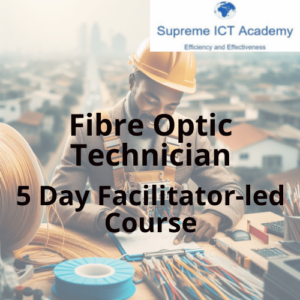Day 1: Fundamentals of Optic Fibre
Morning Session: Introduction to Optic Fibre
- Welcome and Course Overview
- Introduction of facilitator and participants
- Course objectives and agenda
- Basic Optic Fibre Features and Transmission Principles
- History and evolution of optic fibre technology
- Structure and types of optic fibres (single-mode, multi-mode)
- Light propagation and reflection in optic fibres
- Transmission principles (attenuation, dispersion, and bandwidth)
Afternoon Session: Optic Fibre Network Architecture
- Components of Optic Fibre Networks
- Core, distribution, and access networks
- Fibre to the Home (FTTH) and its importance
- Key components: fibres, connectors, splices, and cables
- Network Design and Topologies
- Point-to-point and point-to-multipoint architectures
- Passive Optical Networks (PON) and Active Optical Networks (AON)
- Practical exercises: Drawing basic network diagrams
End-of-Day Activity
- Q&A and Review Session
- Recap of key concepts learned
- Open forum for questions and clarifications
Day 2: Optic Fibre Testing Instruments and Power Meter Usage
Morning Session: Introduction to Optic Fibre Test Instruments
- Overview of Test Instruments
- Types of test instruments: Power Meters, Light Sources, and Optical Time Domain Reflectometers (OTDR)
- Selection criteria for test instruments based on network requirements
- Using a Power Meter
- Principles of power meter operation
- Measuring optical power and loss
- Calibration and maintenance of power meters
Afternoon Session: Practical Exercises with Power Meters
- Hands-on Training: Basic Testing with Power Meters
- Setting up and using power meters
- Conducting insertion loss tests
- Documenting and interpreting test results
- Troubleshooting Techniques
- Common issues and troubleshooting methods
- Practical scenarios and case studies
End-of-Day Activity
- Group Discussion and Knowledge Sharing
- Sharing experiences and best practices
- Facilitator-led discussion on common challenges and solutions
Day 3: Advanced Testing with OTDR and Result Interpretation
Morning Session: Introduction to OTDR
- OTDR Basics
- Function and working principles of OTDR
- Key features and specifications
- Selecting an appropriate OTDR for different testing scenarios
- Setting Up and Using OTDR
- Step-by-step guide to OTDR setup
- Conducting basic tests and understanding traces
Afternoon Session: Interpreting OTDR Results
- Reading and Analyzing OTDR Traces
- Identifying events: connectors, splices, and faults
- Understanding event types and their implications
- Using software tools for advanced analysis
- Practical Exercises: OTDR Testing
- Performing end-to-end testing
- Simulating and diagnosing faults in test scenarios
- Reporting and documenting findings
End-of-Day Activity
- Final Review and Assessment
- Comprehensive review of course content
- Written assessment to evaluate understanding
- Feedback session and course evaluation
Certification
- Awarding of Certificates
- Presentation of completion certificates to participants
Additional Resources
- Reading Materials and Reference Guides
- List of recommended books, articles, and online resources





